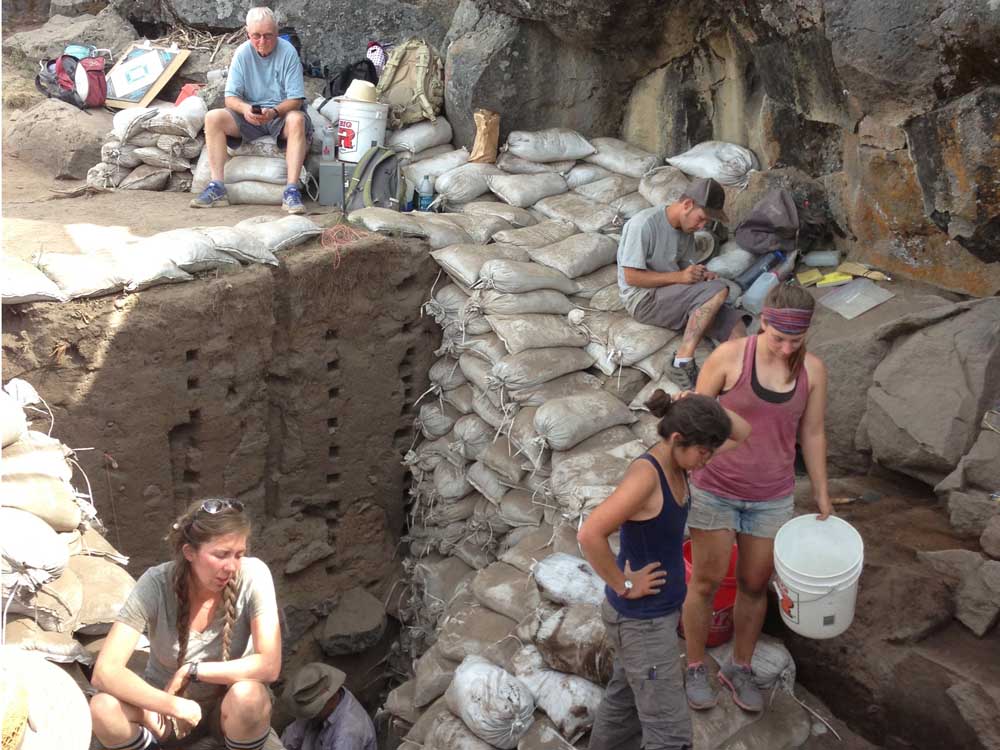Links to prehistoric past found in Central Oregon
Published 12:00 am Thursday, March 12, 2015

- Patrick O'Grady / University of Oregon / Submitted photoStudents with the University of Oregon's field school during a 2013 dig at Rimrock Draw Rockshelter near Riley.
The mission for archaeologists and students digging this summer in the High Desert near Riley is clear — find more Mount St. Helens ash and hopefully more evidence of prehistoric people.
“I have a feeling this is going to be a busy year,” Patrick O’Grady, an archaeologist with the University of Oregon in Eugene, said Wednesday.
A find O’Grady’s team unearthed in 2012 of a human-made tool possibly more than 15,000 years old sparked national and international media interest when announced last week by the Bureau of Land Management. The tool could be a sign of one of the oldest known sites of human occupation in western North America.
Now O’Grady and Scott Thomas, an archaeologist with the BLM office in Burns, face the tough task of convincing the archaeological world the age of the artifact they found at Rimrock Draw Rockshelter .
“We need more artifacts to hang our hat on,” Thomas said Wednesday. “The evidence we have is good, but it is so limited.”
Found below more than 12 feet of dirt, the “unquestionably human-made tool” was under a layer of volcanic ash determined to be from a Mount St. Helens eruption about 15,400 years ago, O’Grady said.
Finding more ash would show a volcanic seal covers an ancient site, archaeologists said, and finding more artifacts would show the tool found in 2012 was not just an artifact out of place, one that perhaps rolled down a rodent hole or slid under the ash layer another way.
When they resume digging in June and July, archaeologists leading about two dozen students from colleges and universities from around the world hope to determine the extent of the ash layer and look for more artifacts underneath. More artifacts would lead to a peer-reviewed journal article detailing what was learned at Rimrock Draw.
A prehistoric person likely made the multi-tool, which is smaller than an egg, by chipping away flakes from an orange agate, Thomas said. The tool features three functional sides, O’Grady said: one with saw teeth, one with a sharp cutting edge and a scraper.
“My partner down at the BLM (Thomas) calls it a Swiss Army knife, and there is good reason for him to call it that because there are different edges for different purposes,” O’Grady said.
The scraper edge was likely used on hides from bison that once roamed Central Oregon. Tests of blood residue found on the tool show it was bovine.
Orange agate is not typically found around Riley, so a mystery remains about how the tool ended up where it did.
“We don’t know where it came from,” O’Grady said, “but it is definitely not a local source.”
If O’Grady, Thomas and the students prove the tool’s age, it would not be the first archaeological find in the region to potentially require a rewrite of human history of North America. A 2008 article in the journal Science explained how another field team found coprolites, or dried ancient excrement, from people showing they had been in the Paisley Caves about 14,300 years ago.
The coprolite dating was significant.
Even earlier
Previously, the Clovis culture used to be thought of as the first people to come to North America from Asia. Clovis artifacts, which date back about 13,000 years, were found around Central Oregon and the United States.
Now the discovery of the tool at Rimrock Draw could predate the finds at the Paisley Caves, near the town of Paisley, about 130 miles southeast of Bend.
“If that is the case, then certainly you are looking at people being in this area 16,000 years and even substantially earlier than we see at the Paisley Caves,” said Dennis Jenkins, senior research archaeologist at the University of Oregon Museum of Natural and Cultural History. Jenkins is also director of U O’s field school, which gives students a chance to work at places like Rimrock Draw and the Paisley Caves in the summer.
The characteristics of Rimrock Draw — a rock shelter exposed to rain — and Paisley Caves lead to different signs of prehistoric people being found at each. Moisture from rain causes organic matter to decompose, unlike in a dry cave environment.
Having led digs at the Paisley Caves from 2002 until 2011, Jenkins is now focused on another site. This summer, like last, he and a crew of about a dozen students are set to dig deep into Connley Caves near Fort Rock. In the late 1960s, Stephen Bedwell, then a U O graduate student, found a piece of charcoal that dated back about 13,000 years.
Like O’Grady and Thomas’ search to verify their find, Jenkins hopes to confirm what Bedwell found.
“There is clearly something very old at the cave,” he said. “The question is, what is it, and is it cultural?”
— Reporter: 541-617-7812, ddarling@bendbulletin.com






